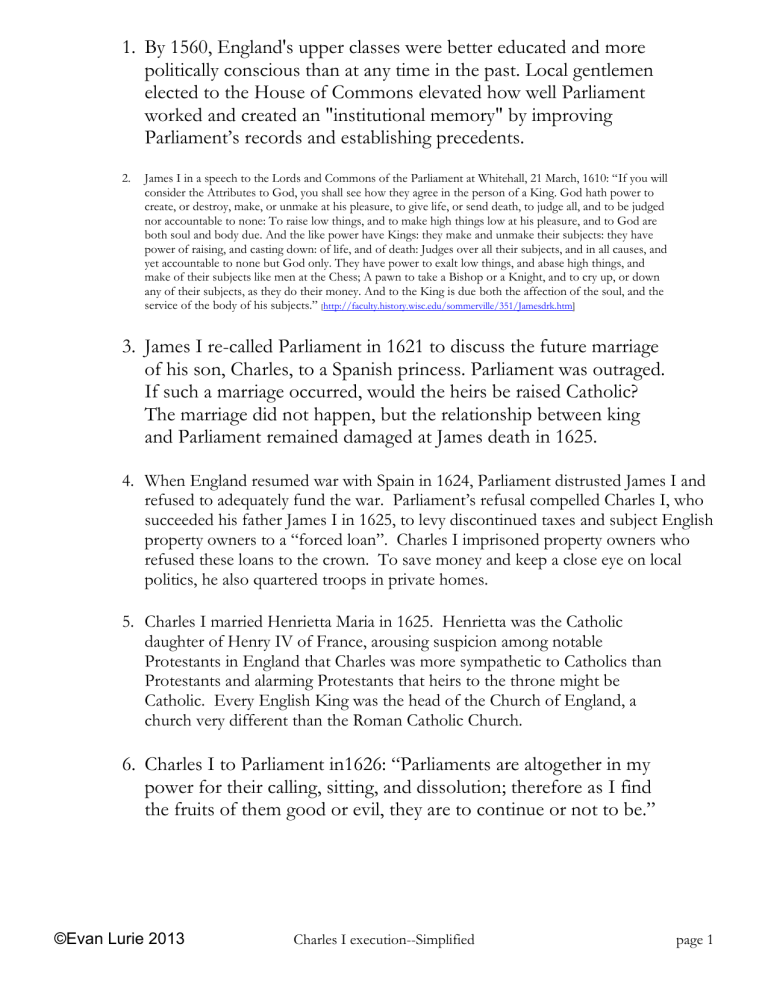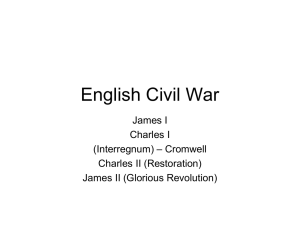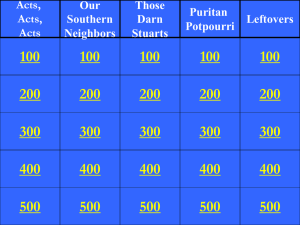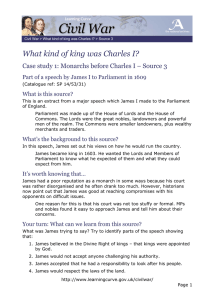
1. By 1560, England's upper classes were better educated and more politically conscious than at any time in the past. Local gentlemen elected to the House of Commons elevated how well Parliament worked and created an "institutional memory" by improving Parliament’s records and establishing precedents. 2. James I in a speech to the Lords and Commons of the Parliament at Whitehall, 21 March, 1610: “If you will consider the Attributes to God, you shall see how they agree in the person of a King. God hath power to create, or destroy, make, or unmake at his pleasure, to give life, or send death, to judge all, and to be judged nor accountable to none: To raise low things, and to make high things low at his pleasure, and to God are both soul and body due. And the like power have Kings: they make and unmake their subjects: they have power of raising, and casting down: of life, and of death: Judges over all their subjects, and in all causes, and yet accountable to none but God only. They have power to exalt low things, and abase high things, and make of their subjects like men at the Chess; A pawn to take a Bishop or a Knight, and to cry up, or down any of their subjects, as they do their money. And to the King is due both the affection of the soul, and the service of the body of his subjects.” [http://faculty.history.wisc.edu/sommerville/351/Jamesdrk.htm] 3. James I re-called Parliament in 1621 to discuss the future marriage of his son, Charles, to a Spanish princess. Parliament was outraged. If such a marriage occurred, would the heirs be raised Catholic? The marriage did not happen, but the relationship between king and Parliament remained damaged at James death in 1625. 4. When England resumed war with Spain in 1624, Parliament distrusted James I and refused to adequately fund the war. Parliament’s refusal compelled Charles I, who succeeded his father James I in 1625, to levy discontinued taxes and subject English property owners to a “forced loan”. Charles I imprisoned property owners who refused these loans to the crown. To save money and keep a close eye on local politics, he also quartered troops in private homes. 5. Charles I married Henrietta Maria in 1625. Henrietta was the Catholic daughter of Henry IV of France, arousing suspicion among notable Protestants in England that Charles was more sympathetic to Catholics than Protestants and alarming Protestants that heirs to the throne might be Catholic. Every English King was the head of the Church of England, a church very different than the Roman Catholic Church. 6. Charles I to Parliament in1626: “Parliaments are altogether in my power for their calling, sitting, and dissolution; therefore as I find the fruits of them good or evil, they are to continue or not to be.” ©Evan Lurie 2013 Charles I execution--Simplified page 1 7. Kings are above all, “inferior to none, to no man, to no multitudes of men, to no Angell, to no order of Angels.” Thus “all the significations of a Royall pleasure, are, and ought to be, to all Loyal subjects, in the nature and force of a Command.” Subjects must either obey the king’s sovereign will—“which gives a binding force to all his Royall Edicts”—even if “flatly against the Law of God,” or suffer patiently. Bishop Roger Maynwaring (chaplain to Charles), Religion and Allegiance, 4 July 1627, modified [http://oll.libertyfund.org/simple.php?id=810] 8. Parliament drafted the Petition of Rights in 1628 and requested Charles I sign it. The Petition recited many principles from the Magna Carta, including that there should be no forced loans or taxation without the consent of Parliament, that imprisonment without due cause and quartering troops in private homes exceeded the authority of the crown, and that martial law could not be used in times of peace. 9. Charles I accepted the Petition of Rights presented in 1628, but after further conflicts he adjourned Parliament shortly after in 1629. For the next 11 years, Charles I ruled without convening Parliament once. 10. Anglican Church Archbishop William Laud (appointed by and with the blessing of Charles I) attempted to force all churches in Scotland to use a prayer book nearly identical to the Anglican Book of Common Prayer in 1637. Accustomed to their own practice of Christianity and proud of their own liturgy and especially their independence, the Scots rebelled and declared war on Charles I. 11. “Since the breach of the last Parliament, his majesty hath, by a new book of rates, very much increased the burden upon merchandise, and now tonnage and poundage, old and new impositions, are all taken by prerogative, without any grant in Parliament, or authority of law, as we conceive…Men’s goods are seized, their legal suits are stopped, and justice denied to those that desire to take the benefit of the law. The great sums of money received upon these impositions, intended for the guard of the seas, claimed and defended upon no ground but of public trust, for protection of merchants and defense of the ports, are dispersed to other uses, and a new tax raised for the same purposes.”--John Pym speech in Parliament, 17 April 1640 12. To combat the Scots’ revolt, Charles I convened Parliament in 1640 for funding to raise an army. Parliament refused to authorize any funds until Charles I addressed a long list of religious and political grievances. The King adjourned Parliament shortly after. This became known as the “Short Parliament”. 13. The Scots defeated the English army at the battle of Newburn in August 1640. This defeat compelled Charles to reconvene Parliament in November 1640. Parliament promptly determined that it could not be adjourned without its own consent. ©Evan Lurie 2013 Charles I execution--Simplified page 2 14. Charles I again requested Parliament raise funds for his army to suppress the Scots rebellion in 1641. Parliament preferred to become commander-in-chief of the army rather than entrust it to Charles I. Parliament refused Charles I’s request. 15. In January 1642 Charles I heard rumors that Parliament might impeach Queen Henrietta Maria. Outraged, he entered Parliament in January 1642 to arrest his Parliamentary opponents, but they escaped. Charles left London to raise his own army. Parliament passed the Militia Ordinance of 1642 granting Parliament control over county militias. 16. Charles I ultimately headquartered in Oxford and raised his army. After a series of indecisive battles, the New Model Army crushed the Royalists at the Battle of Naseby in June 1645 and captured Royalist artillery and stores. Charles I's private papers fell into the hands of the Parliamentarians, revealing the full extent of his negotiations to bring over Irish Catholics to fight against Parliament, and his efforts to secure foreign mercenaries and money from abroad. 17. Charles I surrendered to the Army in 1646. While Parliamentary leaders spent fruitless months failing to negotiate a settlement with him, Charles was encouraging uprisings in England and Wales and an invasion from Scotland. 18. The Army put down a series of royalist insurgencies in 1648 in the second Civil War, but afterwards its leaders demanded an end to negotiations with Charles, whom they considered a "man of blood" responsible for waging war on his own people. 19. On 6 December 1648 Colonel Thomas Pride and his soldiers stood outside the entrance to St Stephen's Chapel and, as the Commons convened that morning, arrested 45 Members and excluded a further 186 whom the Army thought were unlikely to support its goal of punishing the King. 20. After this military coup a further 86 Members left in protest. Pride's Purge left a 'Rump' (as it came to be called) of barely 200 Members. Among these, a determined clique unilaterally forced through an 'Act' on 6 January 1649, establishing a court to try Charles I for high treason - ignoring the negative vote a few days before of the small number of peers still sitting in the Lords. 21. During the trial in Westminster Hall in 1649, Charles I disputed the authority of the court and refused to enter a plea. Despite widespread opposition to the trial, a verdict of guilty was pushed through. Only 57 of the 159 commissioners of the high court originally established by the Rump signed the death warrant for Charles. ©Evan Lurie 2013 Charles I execution--Simplified page 3



